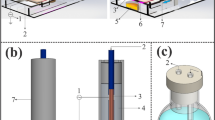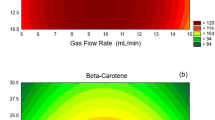Abstract
To improve the microbiological quality of chokeberries, corona discharge plasma jet (CDPJ) was employed as a decontaminating agent. The mean levels of aerobic bacteria and yeast and molds contaminants in chokeberries were 4.78 and 4.87 log CFU/g, respectively; the viable counts were decreased by 2.09 and 1.83 log units following CDPJ treatment for 3 min, respectively. A first-order kinetic model was well-suited for explaining the inactivations. The concentration of total polyphenols of chokeberries was unaffected (up to 3 min treatment), whereas DPPH radical scavenging activity was significantly decreased by CDPJ treatment (2 min and more). CDPJ treatment (all tested times) of chokeberries led to a significant decrease of monomeric anthocyanin content of their corresponding juices, whereas soluble solids content (Brix) and pH were unaffected. After storage at 4 °C for 72 h, juices obtained from CDPJ-treated berries possessed relatively low levels of contaminants with no significant alterations in pH and soluble solids content when compared with controls. In conclusion, CDPJ treatment for 2 min was optimal to improve the microbiological quality of the berries without negatively affecting biochemical qualities of their corresponding juices.



Similar content being viewed by others
References
Blois MS. Antioxidant determinations by the use of a stable free radical. Nature 181: 1199–1200 (1958)
Bursac Kovacevic D, Putnik P, Dragovic-Uzelac V, Pedisic S, Rezek Jambrak A, Herceg Z. Effects of cold atmospheric gas phase plasma on anthocyanins and color in pomegranate juice. Food Chemistry. 190: 317–323 (2016)
Choi S, Puligundla P, Mok C. Corona discharge plasma jet for inactivation of Escherichia coli O157:H7 and Listeria monocytogenes on inoculated pork and its impact on meat quality attributes. Annals of Microbiology. 66: 685–694 (2016)
Choi S, Puligundla P, Mok C. Impact of corona discharge plasma treatment on microbial load and physicochemical and sensory characteristics of semi-dried squid (Todarodes pacificus). Food Science and Biotechnology. 26: 1137–1144 (2017a)
Choi S, Puligundla P, Mok C. Effect of corona discharge plasma on microbial decontamination of dried squid shreds including physico-chemical and sensory evaluation. LWT - Food Science and Technology. 75: 323–328 (2017b)
Delgado AE, Rubiolo AC. Microstructural changes in strawberry after freezing and thawing processes. LWT - Food Science and Technology. 38: 135–142 (2005)
Denev PN, Kratchanov CG, Ciz M, Lojek A, Kratchanova MG. Bioavailability and antioxidant activity of black chokeberry (Aronia melanocarpa) polyphenols: in vitro and in vivo evidences and possible mechanisms of action: a review. Comprehensive Reviews in Food Science and Food Safety. 11: 471–489 (2012)
Gallagher MJ, Vaze N, Gangoli S, Vasilets VN, Gutsol AF, Milovanova TN, Anandan S, Murasko DM, Fridman AA. Rapid inactivation of airborne bacteria using atmospheric pressure dielectric barrier grating discharge. IEEE Transactions on Plasma Science. 35: 1501–1510 (2007)
Genchev R, Angelova G, Laskova I, Gotcheva V, Angelov A. Mycoflora of fresh chokeberry (Aronia melanocarpa) and ochratoxin-producing ability of Penicillium isolates. Quality Assurance and Safety of Crops & Foods. 7: 123–131 (2015)
Horszwald A, Julien H, Andlauer W. Characterisation of Aronia powders obtained by different drying processes. Food Chemistry. 141: 2858–2863 (2013)
KFDA. Korean Food Standards Codex (Vol. 2). Chungbuk, Korea: Korea Food and Drug Administration, 9.3.1.1-9.3.18.2 (2011)
Kim JW, Puligundla P, Mok C. Microbial decontamination of dried laver using corona discharge plasma jet (CDPJ). Journal of Food Engineering. 161: 24–32 (2015)
Lee HW, Nguyen TTT, Lee HB. First report of post-harvest fruit rot of Aronia melanocarpa caused by Fusarium tricinctum in Korea. The Korean Journal of Mycology. 44: 68–71 (2016)
Lee J, Durst RW, Wrolstad RE. Determination of total monomeric anthocyanin pigment content of fruit juices, beverages, natural colorants, and wines by the pH differential method: collaborative study. Journal of AOAC International. 88: 1269–1278 (2005)
Lee SA, Kim GW, Hwang ES, Shim JY. Stability of anthocyanin pigment in Aronia Makgeolli. Food Engineering Progress. 18: 374–381 (2014)
Opoku‐Nkoom W. Safety and quality characteristics of freeze‐defrost cycles in muscle foods. EC Nutrition 1: 140–144 (2015)
Ray PD, Huang BW, Tsuji Y. Reactive oxygen species (ROS) homeostasis and redox regulation in cellular signaling. Cellular Signalling. 24: 981–990 (2012)
Shin D, Choe T. Study on the bioactive characteristics of Aronia extract as a cosmatic raw material. Korean Journal of Aesthetics and Cosmetology. 13: 275–283 (2015)
Singleton VL, Rossi JA. Colorimetry of total phenolics with phosphomolybdic-phosphotungstic acid reagents. American Journal of Enology and Viticulture. 16: 144–158 (1965)
Acknowledgements
We acknowledge funding from the Ottogi Foundation, Korea.
Author information
Authors and Affiliations
Corresponding author
Ethics declarations
Conflicts of interest
The authors declare no conflicts of interest.
Additional information
Publisher's Note
Springer Nature remains neutral with regard to jurisdictional claims in published maps and institutional affiliations.
Rights and permissions
About this article
Cite this article
Park, Yj., Puligundla, P. & Mok, C. Decontamination of chokeberries (Aronia melanocarpa L.) by cold plasma treatment and its effects on biochemical composition and storage quality of their corresponding juices. Food Sci Biotechnol 30, 405–411 (2021). https://doi.org/10.1007/s10068-020-00867-8
Received:
Revised:
Accepted:
Published:
Issue Date:
DOI: https://doi.org/10.1007/s10068-020-00867-8




